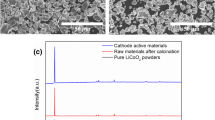Abstract
Recycling of cathode material of spent lithium-ion batteries (LIBs) is important for recovering critical metals and protecting the environment. This study thus proposes a sustainable recycling process for cathode material (nickel-cobalt-manganese/NCM chemistry) via leaching with an acidic organophosphorus extractant, di-(2-ethylhexyl)phosphoric acid/D2EHPA and copper (current collector) as the reducing agent. The effects of leaching parameters, including stirring speed, Cu amount, D2EHPA concentration, temperature, and time were investigated. The leached metals on the loaded D2EHPA were recovered via stripping using pH-controlled aqueous solutions. Using D2EHPA for leaching allows process intensification because it integrates leaching and solvent extraction (SX) in one-stage operation. It also reduces the consumption of aqueous solutions, thereby minimizing wastewater generation.
Access this chapter
Tax calculation will be finalised at checkout
Purchases are for personal use only
Similar content being viewed by others
References
Chen X, Chen Y, Zhou T, Liu D, Hu H, Fan S (2015) Hydrometallurgical recovery of metal values from sulfuric acid leaching liquor of spent lithium-ion batteries. Waste Manage 38:349–356
Chen Z, Zhang W, Yang Z (2019) A review on cathode materials for advanced lithium ion batteries: microstructure designs and performance regulations. Nanotechnology 31(1):012001
Dalini EA, Karimi G, Zandevakili S, Goodarzi M (2021) A review on environmental, economic and hydrometallurgical processes of recycling spent lithium-ion batteries. Miner Process Extr Metall Rev 42(7):451–472
Garole DJ, Hossain R, Garole VJ, Sahajwalla V, Nerkar J, Dubal DP (2020) Recycle, recover and repurpose strategy of spent Li-ion batteries and catalysts: current status and future opportunities. Chemsuschem 13(12):3079–3100
Hawkes SJ (1996) All positive ions give acid solutions in water. J Chem Educ 73(6):516
Joulié M, Billy E, Laucournet R, Meyer D (2017) Current collectors as reducing agent to dissolve active materials of positive electrodes from Li-ion battery wastes. Hydrometallurgy 169:426–432
Kang J, Sohn J, Chang H, Senanayake G, Shin SM (2010) Preparation of cobalt oxide from concentrated cathode material of spent lithium ion batteries by hydrometallurgical method. Adv Powder Technol 21(2):175–179
Lei S, Sun W, Yang Y (2022) Solvent extraction for recycling of spent lithium-ion batteries. J Hazard Mater 424:127654
Nguyen VT, Lee J-C, Jeong J, Kim BS, Pandey BD (2014) Selective recovery of cobalt, nickel and lithium from sulfate leachate of cathode scrap of Li-ion batteries using liquid-liquid extraction. Met Mater Int 20:357–365
Shuya L, Yang C, Xuefeng C, Wei S, Yaqing W, Yue Y (2020) Separation of lithium and transition metals from leachate of spent lithium-ion batteries by solvent extraction method with Versatic 10. Sep Purif Technol 250:117258
Wu J, Zheng M, Liu T, Wang Y, Liu Y, Nai J, Zhang L, Zhang S, Tao X (2022) Direct recovery: a sustainable recycling technology for spent lithium-ion battery. Energy Storage Mater 54:120–134
Yang H, Deng B, Jing X, Li W, Wang D (2021) Direct recovery of degraded LiCoO2 cathode material from spent lithium-ion batteries: efficient impurity removal toward practical applications. Waste Manage 129:85–94
Acknowledgements
This work was supported by the Korea Institute of Energy Technology Evaluation and Planning 538 (KETEP) grant funded by the Korea government (MOTIE) (20217510100080, Development of 539 critical metal recovery technologies (capacity of 200 kg/day) from low-grade solid wastes for the 540 foundation of open access recycling platform).
Author information
Authors and Affiliations
Corresponding author
Editor information
Editors and Affiliations
Rights and permissions
Copyright information
© 2024 The Minerals, Metals & Materials Society
About this paper
Cite this paper
Kurniawan, K., Kim, S., Lee, H., Bae, M., Kim, H., Lee, Jc. (2024). Leaching of Critical Metals from Spent Lithium-Ion Battery Using Acidic Organophosphorus Extractant. In: Forsberg, K., et al. Rare Metal Technology 2024. TMS 2024. The Minerals, Metals & Materials Series. Springer, Cham. https://doi.org/10.1007/978-3-031-50236-1_14
Download citation
DOI: https://doi.org/10.1007/978-3-031-50236-1_14
Published:
Publisher Name: Springer, Cham
Print ISBN: 978-3-031-50235-4
Online ISBN: 978-3-031-50236-1
eBook Packages: Chemistry and Materials ScienceChemistry and Material Science (R0)




